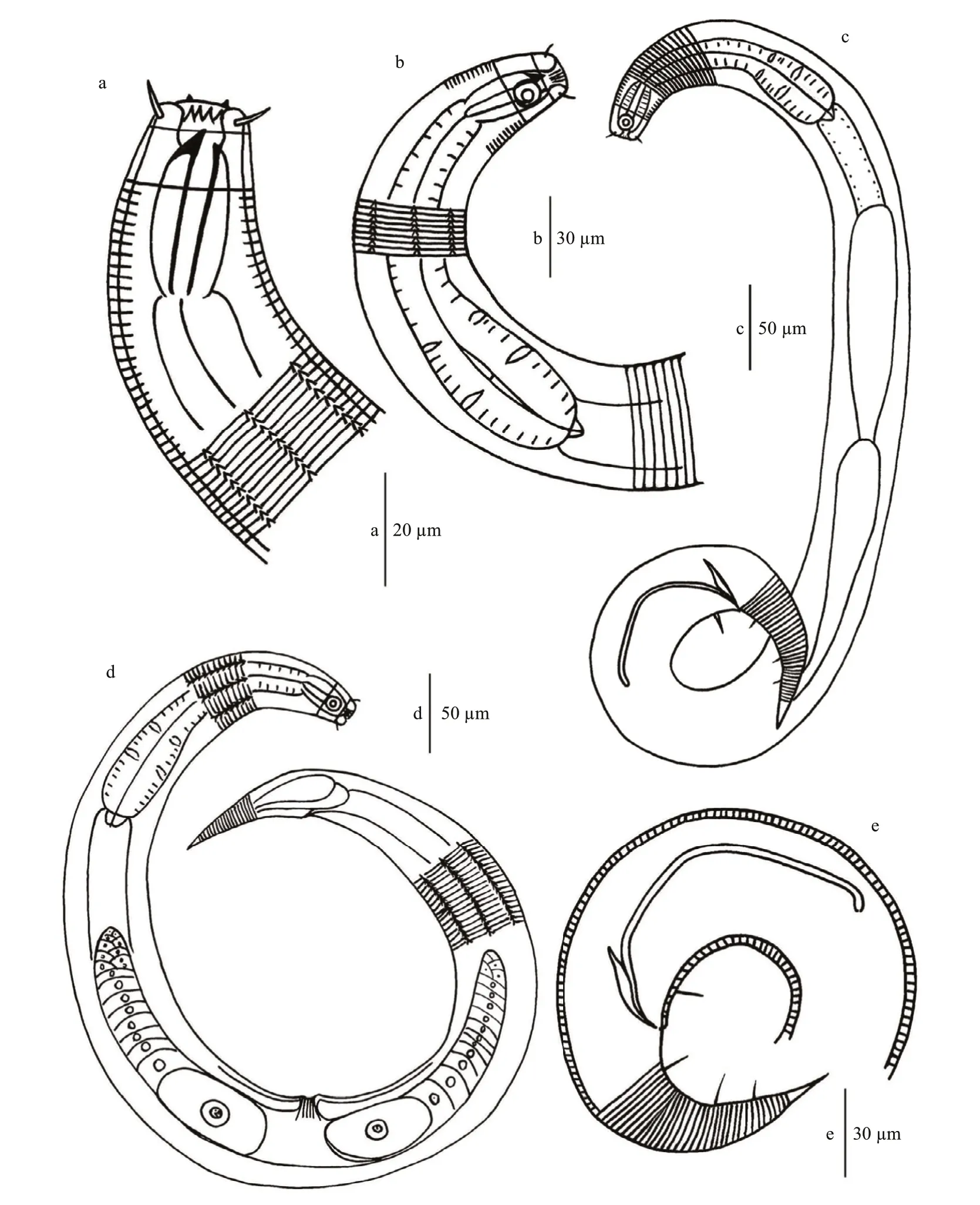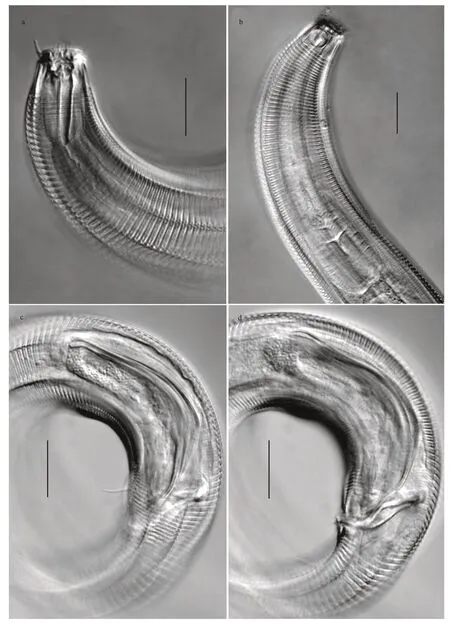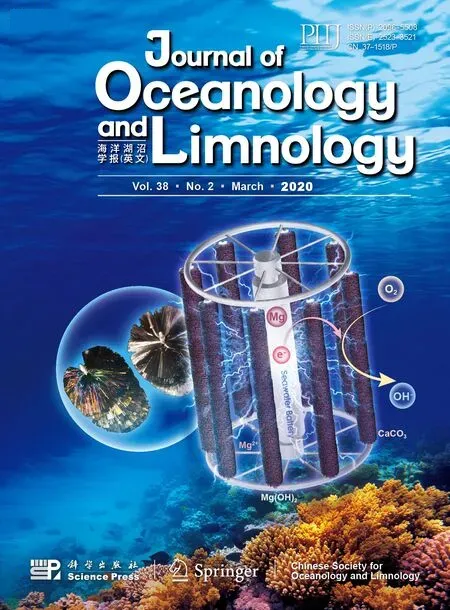A new free-living marine nematode species of Rhinema from the South China Sea*
ZHAI Hongxiu HUANG Mian HUANG Yong
1 College of Life Sciences, Liaocheng University, Liaocheng 252059, China
2 Department of Marine Organism Taxonomy and Phylogeny, Institute of Oceanology, Chinese Academy of Sciences, Qingdao 266071, China
3 University of Chinese Academy of Sciences, Beijing 100049, China
Abstract A new free-living marine nematode species of the genus Rhinema belonging to the family Monoposthiidae was collected from marine sediments in the Qiongzhou Strait of the South China Sea,and it is described here as Rhinema longispicula sp. nov. The new species is characterized by coarsely annulated cuticle with 12 longitudinal ridges (alae) marked as reversed V-shaped. The f irst and second annuli broader and form a kind of a cephalic capsule. The amphideal fovea circular, situated in the middle of the broad second annulus, not surrounded by dense annulations. Buccal cavity cylindrical with a large dorsal tooth. Pharynx with a prominent anterior pharyngeal bulb and an elongated terminal bulb. Elongate spicules strongly curved, with cephalated proximal end and pointed distal end. Gubernaculum boat-shaped,without apophysis. A long and blunt precloacal seta present. Female with two opposed, outstretched ovaries.
Keyword: Rhinema longispicula sp. nov.; free-living marine nematode; taxonomy
1 INTRODUCTION
The genusRhinemais a small and rare genus. At present, only two species have been recorded since it was proposed with the type speciesRhinema retrorsumby Cobb in 1920. The two species areRhinemaretrorsumCobb, 1920 (Cobb, 1920) andRhinemaexquisitumTimm, 1961 (Timm, 1961). The genus is characterized by cuticle thick and coarsely annulated. Longitudinal alae extending throughout the body. Anterior sensilla pattern in 6+6+4, both inner and outer labial sensilla as papilliform or setiform, cephalic sensilla setiform. Amphideal fovea circular, situated on the second annulus. Buccal cavity deep with a large dosal tooth opposed to small ventrosublateral teeth. Pharynx with posterior bulb. Spicules and gubernaculum present. Female with two ovaries(Tchesunov, 2014).
Seabed sediment samples were collected in many sites from intertidal to sublittoral regions during past few years with the aim to study the biodiversity of free-living marine nematodes in the South China Sea.More than 200 nematode species have been identif ied from these habitats (Huang et al., 2018, 2019b; Jia and Huang, 2019). Among them, an unrecorded species was identif ied and is described here asRhinemalongispiculasp. nov.
2 MATERIAL AND METHOD
In February 2017, seaf loor sediments were obtained from a grid of three sampling stations from Qiongzhou Strait in the South China Sea. The sediment was obtained using a Gray-O’Hara box corer, and the samples were taken using a sawn-off syringe with a 2.6-cm inner diameter. The samples were taken to a depth of 8 cm and divided into three sections, 0-2, 2-5,and 5-8 cm, then f ixed with equivalent 10% formalin in seawater for long-term preservation. Sampling,sorting and slide mounting as already indicated in our previous papers (Huang et al., 2019a; Huang and Sun,2019; Jia and Huang, 2019). All measurements are made using Leica LAS X version 3.3.3. All curved structures were measured along the arc. The type specimens are deposited in the Marine Biological Museum of Chinese Academy of Sciences, Qingdao.

Fig.1 Rhinema longispicula sp. nov.
3 SPECIES DESCRIPTION
Order Desmodorida De Coninck, 1965
Family Monoposthiidae Filipjev, 1934
GenusRhinemaCobb, 1920
Rhinemalongispiculasp. nov (Figs. 1-2)
3.1 Type material
Four males, two females, and six juveniles were obtained. Four males, two female and one juvenile measured. Holotype male on slide NH17-0-2-28-12.Paratypes on NH17-0-2-28-13, NH17-0-2-28-3 and NH17-0-2-157-1, NH17-0-2-157-2.

Fig.2 Rhinema longispicula sp. nov.

Table 1 Individual measurements (in μm except a, b, c and V%) of Rhinema longispicula sp. nov.
3.2 Type locality and habitat
Holotype male and paratype males, females and juveniles were found at Station NH17-2 of Qiongzhou Strait, 13 m depth in silt-clay sediments, surface layer between 0-2 cm.
3.3 Etymology
The species name composed of the Latin adjective longus (long) and the Latin noun spicule, referring to the elongate spicules of the species.
3.4 Measurement
All measurement data are given in Table 1.
3.5 Description
Body cylindrical with attenuated head end and conical tail end, 840-886 μm long. Greatest body diameter at the middle of body, 44-57 μm wide.Cuticle coarsely annulated, with 12 longitudinal ridges (alae) marked as V-shaped. The f irst and second annuli are broader and form a kind of a cephalic capsule. The lips well developed. The inner labial sensilla not observed; the six outer labial sensilla very short, papilliform. The four cephalic sensilla setiform,7 μm long and situated at the basis of the lip region.The amphideal fovea circular, 9 μm diameter (41% of the corresponding body diameter), and located in the middle of the broad second annulus, not surrounded by dense annulations. Buccal cavity cylindrical and cuticularized, 32-33 μm long and 5 μm wider. One big dorsal tooth, two smaller ventro-sublateral teeth present. Pharynx muscular with a prominent anterior pharyngeal bulb and an elongated terminal bulb.Nerve ring not observed. Ventral gland and excretory pore not found. Tail conical with a non-annulated f inger-like tail tip, 98-105 μm, i.e. 2.9-3.2 cloaca body diameter long. Two rows of longitudinal setae,3-4 pairs, located along subventral portion of tail,each seta 8 μm long. Three contiguous caudal glands with a common opening.
Reproductive system with two testes arranged in tandem. Anterior testis located to left of the intestine,posterior one located to right of the intestine. Spicules elongate, strongly curved, cephalated proximally and pointed distally, 120-138 μm, i.e. 3.8-3.9 cloaca body diameter long. Gubernaculum (30-32)-μm long,boat-shaped, without apophysis. One blunt precloacal seta, 10-μm long. Precloacal supplement absent.
Females. Resembles males in most aspects except cephalic setae shorter, only 4-μm long, tail slightly shorter (74-86 μm, i.e. 2.7-2.9 anal body diameter long) and without caudal setae. Reproductive system didelphic with two opposed, outstretched ovaries.Uterus a wide tube. Vagina straight and cuticularized,0.25 times vulval body diameters long. Vaginal glands present. Vulva with slightly raised lips and situated at just post-mid of body.
3.6 Diff erential diagnosis and discussion
Rhinemalongispiculasp. nov. is characterized by coarsely annulated cuticle with 12 longitudinal ridges(alae) marked as reversed V-shaped. The f irst and second annuli broader and form a kind of a cephalic capsule. Circular amphideal fovea situated in the middle of the broad second annulus. Cylindrical buccal cavity with a large dorsal tooth. Pharynx with a prominent anterior pharyngeal bulb and an elongated terminal bulb. Elongate spicules strongly curved,cephalated proximally and pointed distally.Gubernaculum boat-shaped without apophysis. A stoutly precloacal seta present, precloacal supplement absent. Female with two opposed, outstretched ovaries. It diff ers from the other two known species of this genus,RhinemaretrorsumCobb, 1920 andRhinemaexquisitumTimm, 1961 in having shorter cephalic setae and longer spicules. InRhinema retrorsum, spicules shorter, only 45 μm, i.e. 1.5 cloacal body diameter long (Gerlach, 1963) (vs 120-138 μm, i.e. 3.8-3.9 cloacal body diameter long).Rhinemaexquisitumonly found females, its amphideal fovea surrounded by dense annulations, cephalic setae 18 μm i.e. 1.3 times of head diameter long (vs 4-8 μm, i.e. 0.2-0.5 head diameter long).
4 DATA AVAILABILITY STATEMENT
The authors declare that the data supporting the f indings of this study are available within the article.The data will be available on request from the corresponding author.
5 ACKNOWLEDGMENT
The authors are very thankful to all crew members of R/VKexue3for their kind help in samples collection. We are sincerely grateful to two anonymous referees for providing valuable criticisms and improving on manuscript.
 Journal of Oceanology and Limnology2020年2期
Journal of Oceanology and Limnology2020年2期
- Journal of Oceanology and Limnology的其它文章
- Contribution of surface wave-induced vertical mixing to heat content in global upper ocean*
- Upper ocean response to typhoon Kujira (2015) in the South China Sea by multiple means of observation*
- Inf luence of simulating deep-sea environmental factors on cathodic performance of seawater battery*
- Adsorption characteristics of chitooligosaccharides onto activated charcoal in aqueous solutions*
- Eff ects of hypoxia on survival, behavior, and metabolism of Zhikong scallop Chlamys farreri Jones et Preston 1904*
- Distinct inf luence of trimethylamine N-oxide and high hydrostatic pressure on community structure and culturable deep-sea bacteria*
